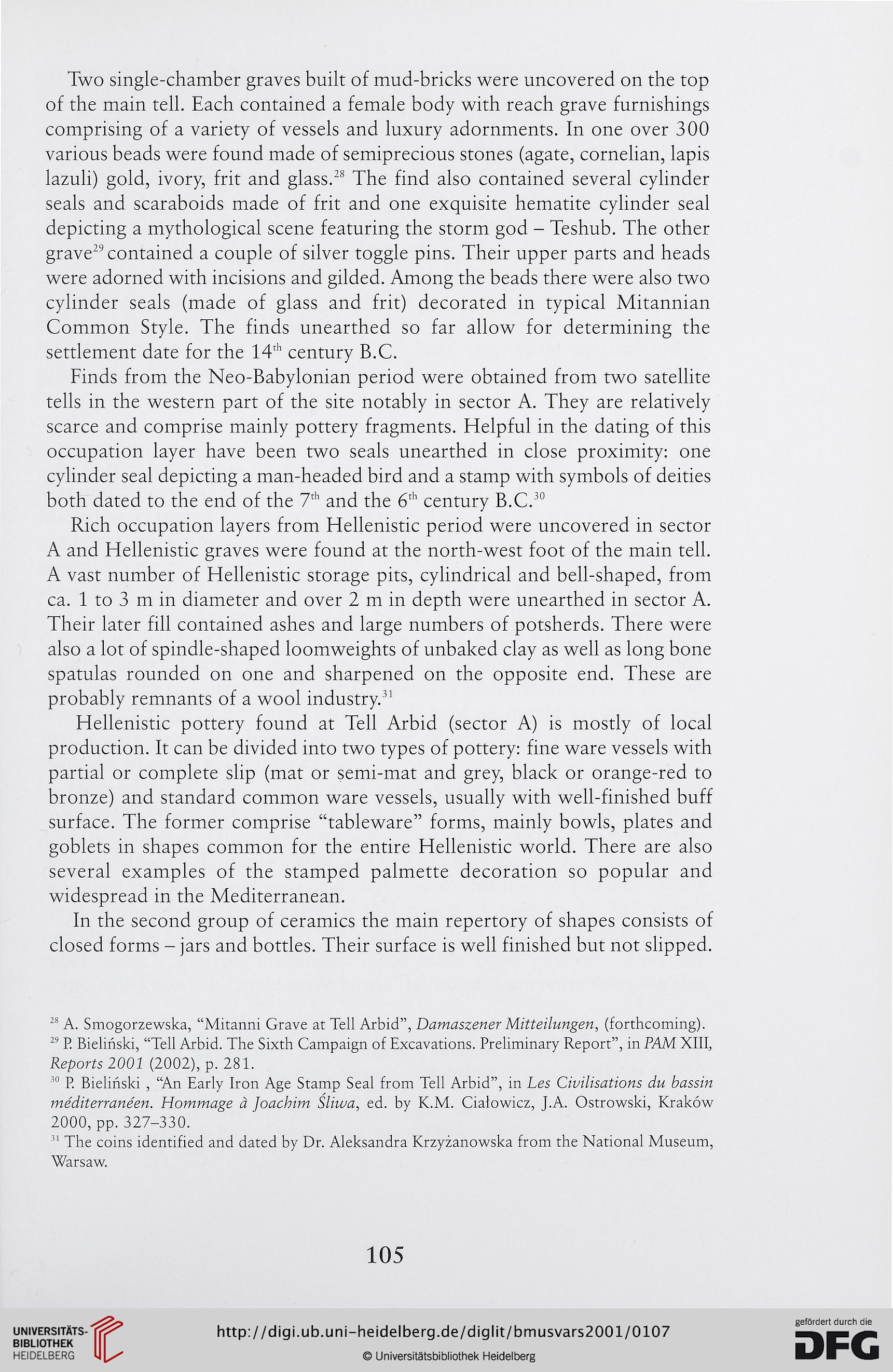Two single-chamber graves built of mud-bricks were uncovered on the top
of the main tell. Each contained a female body with reach grave furnishings
comprising of a variety of vessels and luxury adornments. In one over 300
various beads were found madę of semiprecious Stones (agate, cornelian, lapis
lazuli) gold, ivory, frit and glass.28 The find also contained several cylinder
seals and scaraboids madę of frit and one exquisite hematite cylinder seal
depicting a mythological scene featuring the storm god - Teshub. The other
grave29 contained a couple of silver toggle pins. Their upper parts and heads
were adorned with incisions and gilded. Among the beads there were also two
cylinder seals (madę of glass and frit) decorated in typical Mitannian
Common Style. The finds unearthed so far allow for determining the
settlement datę for the 14th century B.C.
Finds from the Neo-Babylonian period were obtained from two satellite
tells in the western part of the site notably in sector A. They are relatively
scarce and comprise mainly pottery fragments. Helpful in the dating of this
occupation layer have been two seals unearthed in close proximity: one
cylinder seal depicting a man-headed bird and a stamp with symbols of deities
both dated to the end of the 7th and the 6th century B.C.30
Rich occupation layers from Hellenistic period were uncovered in sector
A and Hellenistic graves were found at the north-west foot of the main tell.
A vast number of Hellenistic storage pits, cylindrical and bell-shaped, from
ca. 1 to 3 m in diameter and over 2 m in depth were unearthed in sector A.
Their later fili contained ashes and large numbers of potsherds. There were
also a lot of spindle-shaped loomweights of unbaked clay as well as long bonę
spatulas rounded on one and sharpened on the opposite end. These are
probably remnants of a wool industry.31
Hellenistic pottery found at Tell Arbid (sector A) is mostly of local
production. It can be divided into two types of pottery: fine ware vessels with
partial or complete slip (mat or semi-mat and grey, black or orange-red to
bronze) and standard common ware vessels, usually with well-finished buff
surface. The former comprise “tableware” forms, mainly bowls, plates and
goblets in shapes common for the entire Hellenistic world. There are also
several examples of the stamped palmette decoration so popular and
widespread in the Mediterranean.
In the second group of ceramics the main repertory of shapes consists of
closed forms - jars and bottles. Their surface is well finished but not slipped.
28 A. Smogorzewska, “Mitanni Grave at Tell Arbid”, Damaszener Mitteilungen, (forthcoming).
29 P. Bieliński, “Tell Arbid. The Sixth Campaign of Excavations. Preliminary Report”, in PAM XIII,
Reports 2001 (2002), p. 281.
30 P. Bieliński , “An Early Iron Age Stamp Seal from Tell Arbid”, in Les Civilisations du bassin
mediterraneen. Hommage d Joachim Śliwa, ed. by K.M. Cialowicz, J.A. Ostrowski, Kraków
2000, pp. 327-330.
31 The coins identified and dated by Dr. Aleksandra Krzyżanowska from the National Museum,
Warsaw.
105
of the main tell. Each contained a female body with reach grave furnishings
comprising of a variety of vessels and luxury adornments. In one over 300
various beads were found madę of semiprecious Stones (agate, cornelian, lapis
lazuli) gold, ivory, frit and glass.28 The find also contained several cylinder
seals and scaraboids madę of frit and one exquisite hematite cylinder seal
depicting a mythological scene featuring the storm god - Teshub. The other
grave29 contained a couple of silver toggle pins. Their upper parts and heads
were adorned with incisions and gilded. Among the beads there were also two
cylinder seals (madę of glass and frit) decorated in typical Mitannian
Common Style. The finds unearthed so far allow for determining the
settlement datę for the 14th century B.C.
Finds from the Neo-Babylonian period were obtained from two satellite
tells in the western part of the site notably in sector A. They are relatively
scarce and comprise mainly pottery fragments. Helpful in the dating of this
occupation layer have been two seals unearthed in close proximity: one
cylinder seal depicting a man-headed bird and a stamp with symbols of deities
both dated to the end of the 7th and the 6th century B.C.30
Rich occupation layers from Hellenistic period were uncovered in sector
A and Hellenistic graves were found at the north-west foot of the main tell.
A vast number of Hellenistic storage pits, cylindrical and bell-shaped, from
ca. 1 to 3 m in diameter and over 2 m in depth were unearthed in sector A.
Their later fili contained ashes and large numbers of potsherds. There were
also a lot of spindle-shaped loomweights of unbaked clay as well as long bonę
spatulas rounded on one and sharpened on the opposite end. These are
probably remnants of a wool industry.31
Hellenistic pottery found at Tell Arbid (sector A) is mostly of local
production. It can be divided into two types of pottery: fine ware vessels with
partial or complete slip (mat or semi-mat and grey, black or orange-red to
bronze) and standard common ware vessels, usually with well-finished buff
surface. The former comprise “tableware” forms, mainly bowls, plates and
goblets in shapes common for the entire Hellenistic world. There are also
several examples of the stamped palmette decoration so popular and
widespread in the Mediterranean.
In the second group of ceramics the main repertory of shapes consists of
closed forms - jars and bottles. Their surface is well finished but not slipped.
28 A. Smogorzewska, “Mitanni Grave at Tell Arbid”, Damaszener Mitteilungen, (forthcoming).
29 P. Bieliński, “Tell Arbid. The Sixth Campaign of Excavations. Preliminary Report”, in PAM XIII,
Reports 2001 (2002), p. 281.
30 P. Bieliński , “An Early Iron Age Stamp Seal from Tell Arbid”, in Les Civilisations du bassin
mediterraneen. Hommage d Joachim Śliwa, ed. by K.M. Cialowicz, J.A. Ostrowski, Kraków
2000, pp. 327-330.
31 The coins identified and dated by Dr. Aleksandra Krzyżanowska from the National Museum,
Warsaw.
105




